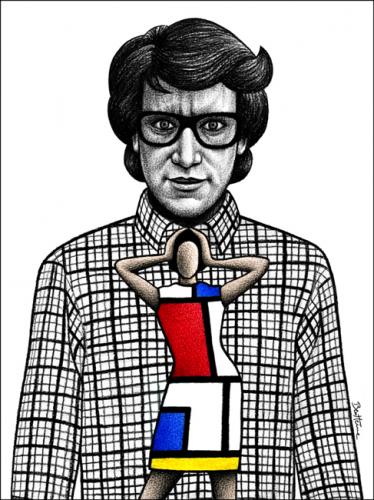Yves Saint Laurent
#14098 / viewed 20968 timesYves Saint Laurent: The man who changed the way women dress forever
By Lisa Adams
He was the king of cutting-edge couture who, by rewriting the rules of fashion, changed forever the way women dress.
Talented, controversial but always cool, Yves Saint Laurent was the last great designer from a generation which made Paris the fashion capital of the world.
With 20th century gurus Christian Dior and Coco Chanel gone, fashionistas could still believe in the power of style through YSL.
His death on Sunday aged 71, following a year-long fight against brain cancer, marks the end of an era.
However, his legacy lives on - as the French president revealed in a glowing tribute yesterday.
Nicolas Sarkozy said: "One of the greatest names in fashion has disappeared.
"Yves Saint Laurent was the first to elevate haute couture to the rank of art, and that gave him global influence.
"He infused his label with his creative genius, elegant and refined personality - discrete and distinguished during a half-century of work in both luxury and ready-to-wear - because he was convinced beauty was a necessary luxury for all men and all women."
Pierre Berge described his former lover and business partner - the first designer to put women in trousers - as a "true creator" who had empowered women.
He said: "Chanel gave women freedom but Saint Laurent gave them power.
"He was a libertarian, anarchic, and he threw bombs at the legs of society."
It's a spark which brought us the ultra elegant tuxedo smoking jacket.
When that hit the catwalks in 1966, it transformed the way ordinary women dressed for the evening.
Worn together with sharply tailored trousers, it offered a modern alternative to the formal evening dress, rapidly becoming a wardrobe staple for women.
The tuxedo has been updated for every collection since then, with supermodel Kate Moss looking effortlessly cool in this season's Le Smoking jacket.
Saint Laurent's label was worth £45million when he sold it to Gucci in 1999 and the most beautiful women on the planet have long clamoured to wear his clothes.
He created Bianca Jagger's iconic white wedding suit as well as dressing stars including Catherine Deneuve, Paloma Picasso and Lauren Bacall.
Supermodel Naomi Campbell said she was blessed to be working for YSL while her colleagues Claudia Schiffer and Carla Bruni hailed him as the most influential designer of his time on his retirement in 2002.
He could only have dreamed about such recognition growing up as a shy boy with a passion for drawing, in Oran, Algeria.
Born the son of a shipping executive on August 1, 1936, the fiercely ambitious Saint Laurent shied away from his
conventional home life to dream of cocktail dresses.
Taunted for being gay, he took refuge in his fascination for clothes.
After escaping to the bright lights of Paris aged 17, Saint Laurent finally discovered people who truly believed in his talents.
He won his place at the prestigious Chambre Syndicale school of haute couture after monopolising a contest sponsored by the International Wool Secretariat.
He had scooped three out of four of the categories - the fourth went to Karl Lagerfeld, now at Chanel.
Months later, in 1954, he was introduced to a man who would change his life, Christian Dior.
Dior was so impressed he hired him on the spot. Aged 21, when most designers are starting out, Saint Laurent was named head of the fashion house after Dior died suddenly.
But four years later, just as his career was really taking off, he was conscripted in to the French army during the Algerian War of Independence.
Already physically frail, his time in service was a horror which haunted the rest of his life.
He suffered a nervous breakdown and endured months of electroshock therapy in a psychiatric unit.
It cost him his chance at Dior but, as he slowly recovered, Saint Laurent bravely started his own label, YSL.
His Rive Gauche boutiques for women were established in 1966, and Le Smoking jacket secured his stardom.
His creation of sleek trouser suits for women perfectly captured the "equality of the sexes" spirit of the era.
His Beatnik chic - a black leather jacket, turtleneck and high boots - was also bang on trend.
Always striking, Saint Laurent saw it as vital to create clothes which women felt comfortable wearing.
His safari-style trouser suits in khaki cotton were instant hits in his Rive Gauche ready-to-wear boutiques in London and Paris.
The navy blue pea coat over white pants - debuted in 1962 - was also one of his hallmarks.
He said: "I have often said that I wish I had invented blue jeans: the most spectacular, the most practical, the most relaxed and nonchalant.
"They have expression, modesty, sex appeal, simplicity - all I hope for in my clothes."
Saint Laurent's strength lay in never being afraid to be different.
He was ahead of his time, the first designer to challenge the blue-eyed, blonde-haired idea of perfection by hiring black models for his shows.
The trouser suits he so fervently believed in quickly triggered controversy away from the catwalk.
Women wearing them were turned away from hotels and restaurants in London and New York.
His see-through blouses, which showed off women's breasts, were next to cause outrage.
But his vision for fashion stretched beyond the cut of the clothes.
He said: "Fashion is not only supposed to make women beautiful, but to reassure them, to give them confidence, to allow them to come to terms with themselves".
Saint Laurent was never afraid to shock the public.
He posed nude in the advertising campaign for Pour Homme, the first YSL men's fragrance.
Then his launch in the mid-Seventies of a perfume called Opium brought accusations that he was condoning drug use.
Drugs - as well as depression and intense loneliness - were a problem for him away from the bright lights and air kisses of the fashion world.
Saint Laurent said: "I've known fear and terrible solitude, tranquillisers and drugs - those phoney friends - the prison of depression and hospitals.
"I've emerged from all this, dazzled but sober."
Despite that loneliness, he created a timeless template for women's fashion.
One of today's hottest designers, Marc Jacobs, admits looking to YSL's Seventies glory years for inspiration.
And Dame of British fashion, Vivienne Westwood, yesterday described YSL as "one of the great couturiers, one of the few who have achieved perfection with everything they touched."
In today's brave new world of fast fashion, froth and window dressing, few achieve that.
He will be missed.
(--> This tribute appeared on http://www.dailyrecord.co.uk)
-------------
Obituary: Yves Saint Laurent(BBC)
Yves Saint Laurent changed the face of the fashion industry when he became chief designer of the House of Dior at the age of 21.
His creations adorned some of the world's most famous women; he counted Catherine Deneuve, Paloma Picasso and Princess Grace of Monaco among his most ardent admirers.
But so much too of what ordinary women wear today has been influenced by Saint Laurent.
He designed clothes that reflected women's changing role in society; more confident personally, sexually and in the work-place.
Yves Saint Laurent was born in Algeria, on 1st August 1936. Although his parents were wealthy (his father owned a chain of cinemas), French Algerians were often looked down upon by people in mainland France.
The young Yves had an unhappy childhood. Because of his homosexuality, he said, he was bullied and generally ill-treated at school.
His mother brought him to Paris and he joined the House of Dior in 1954, and such was his impact that he became chief designer when Christian Dior died three years later.
There followed a period of unremitting success. He was credited with introducing short skirts and leather jackets to the world of haute couture in 1960.
But later that same year his world and career collapsed. He was conscripted into the French Army at the height of the Algerian war, and suffered a nervous breakdown.
After three months in hospital he was discharged from the Army as medically unfit. But his return to the House of Dior was short-lived - he left almost immediately amid rumours that he had been dismissed.
He denied this, and claimed that he had resigned because the fashion house wanted him to work in London.
A lean period followed, but he made a comeback designing costumes for Zizi Jeanmaire, the French cabaret artiste. His love of the theatre led to many more triumphs as a set and costume designer.
Razia Iqbal looks back at the life of Yves Saint Laurent
In 1962, with his business and personal partner, Pierre Berge, he founded what was to become the multi-million-pound Saint Laurent fashion and perfume empire.
His flair re-established him as one of the world's top designers, dictating couture and ready-to-wear fashions. He brought in the safari jacket, the cape, peasant flounces and military blousons.
Trouser suits were almost unheard of before Yves Saint Laurent. Biker jackets, blazers and turtleneck sweaters came courtesy of him. He made women's clothes both more sexy and elegant.
But his personal life was less successful. The depression that ended his military career persisted - his partner, Pierre Berge, once said Saint Laurent had been born with a nervous breakdown. His ego was famously fragile.
In the 1970s and '80s, he retreated into excess, becoming addicted to drink and drugs. He also indulged in what he himself called "an extraordinary sex life".
He and Berge split romantically but remained business partners. Reclusive, Saint Laurent rarely left his Paris flat, where he lived surrounded by a massive art collection.
In 1999, he and Berge, having failed to find a suitable successor of their choice, sold their ready-to-wear company Yves Saint Laurent Rive Gauche to Gucci for $1bn after it had run into financial difficulties.
(--> This obituary appeared on http://news.bbc.co.uk)
-------------
Official Yves Saint Laurent Web Site : http://www.ysl.com/
yvessaintlaurentyslguccidiorpierrebergeelegancedesignerfragranceperfumemodedresswomanpietmondrianartcouturecuttingedgecontroversialgayhomosexualgeniusrobefashioncancercreationlibertariananarchicjacketshirtclothesbenheine




Σχόλια (7)
ΣχολιάστεGuest
, on March 09, 2010 report post απάντηση applause 0
Executive
BenHeine, on September 10, 2009 report post απάντηση applause 0
Editor
Nicoleta Ionescu, on September 10, 2009 report post απάντηση applause 0
Member
Palmas, on June 21, 2008 report post απάντηση applause 0
Member
Nayer, on June 08, 2008 report post απάντηση applause 0
Member
Nizar, on June 07, 2008 report post απάντηση applause 0
Guest
SALUDOS QUIMÉRICOS
, on June 06, 2008 report post απάντηση applause 0